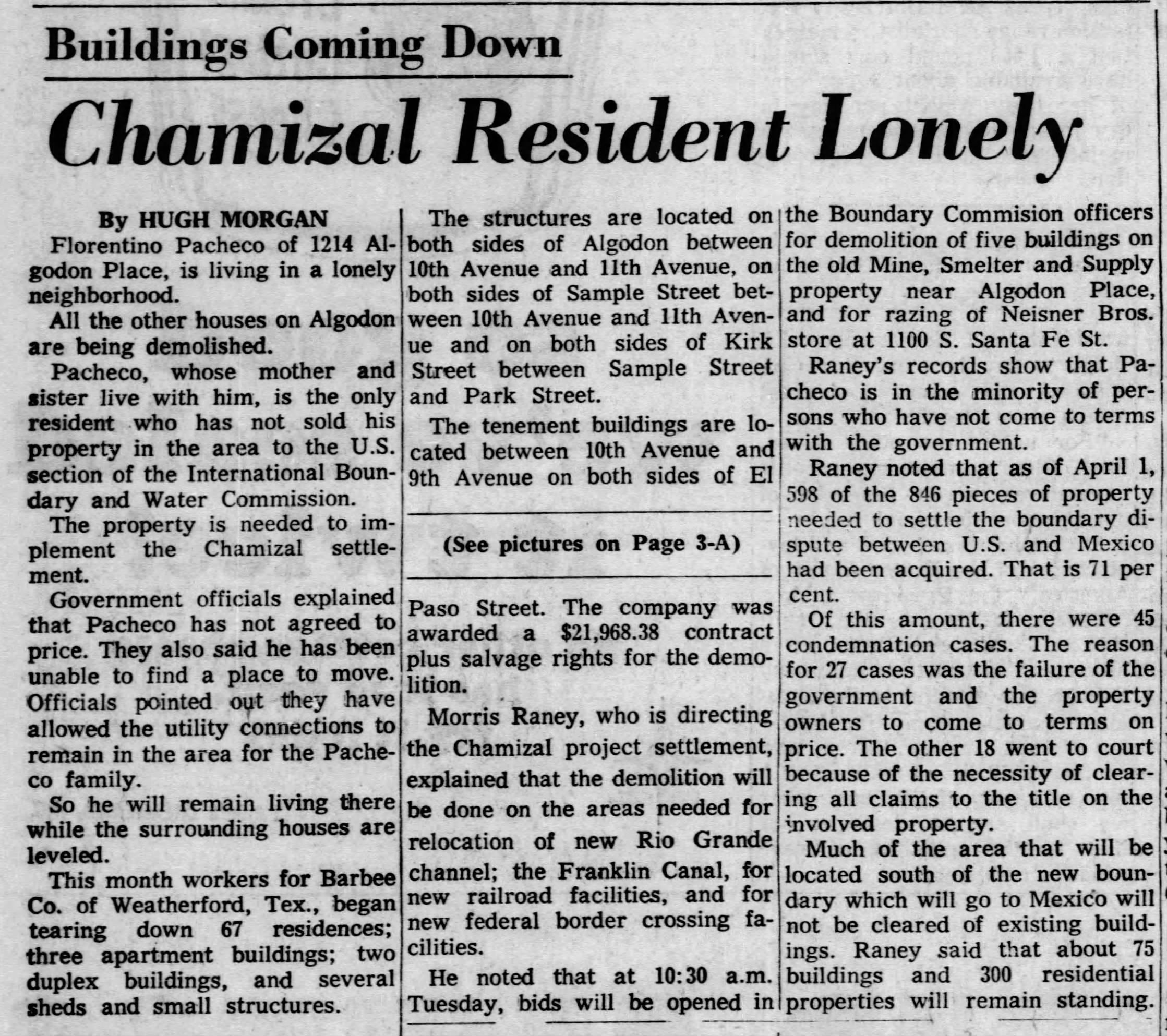Florentino Pacheco (1924-2017)
Florentino Pacheco purchased his Chamizal home in the Cotton Mill Addition to the City of El Paso in 1947. There, he lived with his mother and sister at 1214 Algodon Place.
Born in Tornillo, Texas, and raised in the Ysleta area of El Paso, Florentino Pacheco was a World War II Army veteran. In the 1947 deed of trust for his Cotton Mill property, the contract states the house was constructed under Regulation 33—a low-income housing code that was part of the newly-established Veterans Emergency Housing Program. Pacheco’s home was not unusual, as many homes in the Cotton Mill and Rio Linda Additions were targeted specifically for WWII veterans.
In 1963, when condemnation proceedings for the Chamizal Treaty began, Florentino refused to comply. Not only did he refuse to vacate his home, but he also refused to negotiate with the U.S. federal government on a purchase price for his home. Even once displacement proceedings were well under way in Cotton Mill, Florentino repeatedly rejected the government’s offer of $8,200 for his home. Soon, the Pacheco household was the last family remaining in Cotton Mill, which stood in the path of the settlement’s concrete river canal. Dubbed the lonely “holdout” by local newspapers, Florentino became rather notorious in the city. “Florentino Pacheco of 1214 Algodon Place is living in a lonely place,” reported the El Paso Times in 1966. “All the other houses on Algodon are being demolished.”

In July 1966, the U.S. federal government was granted a court-ordered warrant to enter Florentino’s home, pack up his belongings, and move him and his family into a temporary home in Rio Linda held by the IWBC. This temporary home stood at 1405 E. 12th Street. There, Pacheco was allowed to stay rent-free until a federal court made its decision on the fair-market value of his Cotton Mill property.
The El Paso Times diligently covered Pacheco’s case. Photographs published in the Times showed Pacheco’s home amongst the neighborhood’s ruins. In another photo movers haul Florentino’s belongings into a truck. When asked to comment on his situation, Florentino declined. “I do not want any more publicity,” he told the Times.
-

1966: "Eviction Set for Monday" by El Paso Times
On July, 1966, the El Paso Times announced Florentino Pacheco’s eviction from his Cotton Mill home. In the photograph accompanying this announcement, demolished homes are shown. In the right corner is Florentino’s Cotton Mill home among the ruins of his neighborhood.
-

1966: "Chamizal 'Hold Out' Relocated" by El Paso Herald-Post
On July 18, 1966, Florentino and his family were evicted from their Cotton Mill home. At the time of their eviction, the El Paso Times reported that all other residences in the Cotton Mill Addition had been demolished. “The Pacheco home stands squarely in the proposed channel of the relocated Rio Grande,” reported the Times.
-

1966: Florentino is moved into Rio Linda home at 1405 E. 12th Street
In an article headlined, “Chamizal ‘Holdout’ Moves Out,” the El Paso Times explained that as part of Florentino’s eviction, he and his family were forcibly moved to an empty house in Rio Linda (shown above). This was a temporary measure until Florentino agreed on a selling price for his Cotton Mill home. In Rio Linda, he lived in the former home of Bernando P. Tarango.
-

1966: Workmen tearing down homes in Cotton Mill
The El Paso Times documented demolition proceedings in Cotton Mill. The man shown in the photo above was one of a handful of men hired by the U.S. federal government to to clear the condemned Cotton Mill neighborhood for the relocated Rio Grande canal, railroad tracks, and Border Highway.
There are very few photographs of Florentino Pacheco’s Cotton Mill home—a symbol of Chamizal resistance to forced displacement.
This photograph of the Pacheco house was included in a June 1966 IBWC report on this property’s condemnation proceedings and appraisal. The report was forwarded to Texas Congressman Richard White for his review.
At the time this report was written, most of the homes in Cotton Mill had already been razed and demolished to make way for the Border Highway and relocated Rio Grande concrete canal.
Notice below the razed areas surrounding the Pacheco house.
We know very little about the forced eviction of the Pacheco family from their home of 18 years.
This photograph of the Pachecho home was published in an El Paso Times report on the final condemnation and eviction of the Pacheco family. The report was published on July 16, 1966.
Prior to their eviction, Florentino had fought hard for what he believed was just compensation for his family’s home. In fact, Florentino was one of several defendants in an eminent domain case known as “United States of America v. 6.235 Acres of Land, More or less, in El Paso County, State of Texas, and William E. Johnson Jr., Et Al.”
The case involved 23 properties seized through eminent domain, but whose owners had refused to accept the government’s buy-out offer. In the supporting documents submitted by the International Boundary & Water Commission on behalf of the federal government, we see another—albeit vacated & muted—representation of Florentino’s Cotton Mill home.
-

Tract Map & Description: D-148 Pacheco Lot
This representation of Florentino’s home gives us a sense of its size and layout, but perhaps more than anything it vacates this home of its lived reality.
-

D-148: Florentino Pacheco Lot
This map of Cotton Mill shows each property lot in the subdivision, including Florentino Pacheco’s at D-148. Florentino’s neighbor, Elvira Villa Escajeda (at that time known as Elvira Lacarra) lived just three doors down at lot D-145.




